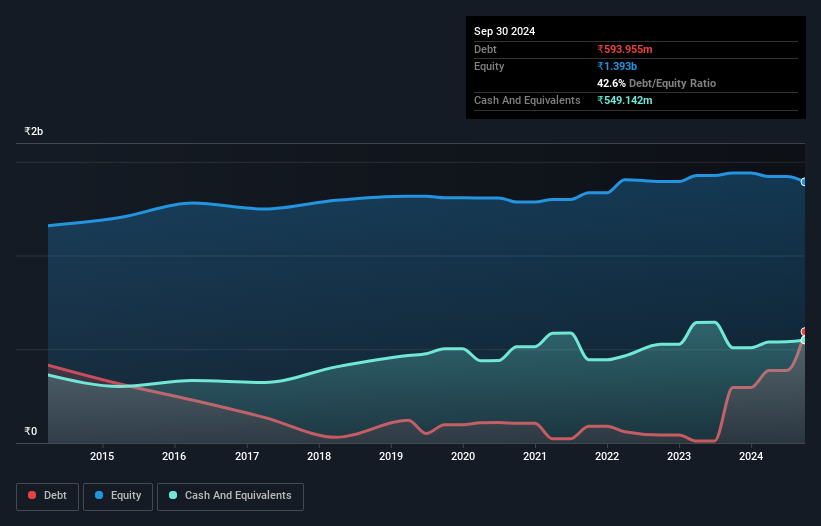
Legendary fund manager Li Lu (who Charlie Munger backed) once said, 'The biggest investment risk is not the volatility of prices, but whether you will suffer a permanent loss of capital.' It's only natural to consider a company's balance sheet when you examine how risky it is, since debt is often involved when a business collapses. As with many other companies Compucom Software Limited (NSE:COMPUSOFT) makes use of debt. But is this debt a concern to shareholders?
When Is Debt A Problem?
Debt assists a business until the business has trouble paying it off, either with new capital or with free cash flow. If things get really bad, the lenders can take control of the business. While that is not too common, we often do see indebted companies permanently diluting shareholders because lenders force them to raise capital at a distressed price. Of course, the upside of debt is that it often represents cheap capital, especially when it replaces dilution in a company with the ability to reinvest at high rates of return. The first step when considering a company's debt levels is to consider its cash and debt together.
View our latest analysis for Compucom Software
What Is Compucom Software's Debt?
As you can see below, at the end of September 2024, Compucom Software had ₹594.0m of debt, up from ₹295.7m a year ago. Click the image for more detail. However, it does have ₹549.1m in cash offsetting this, leading to net debt of about ₹44.8m.

How Strong Is Compucom Software's Balance Sheet?
The latest balance sheet data shows that Compucom Software had liabilities of ₹727.9m due within a year, and liabilities of ₹102.0m falling due after that. On the other hand, it had cash of ₹549.1m and ₹912.4m worth of receivables due within a year. So it can boast ₹631.7m more liquid assets than total liabilities.
This luscious liquidity implies that Compucom Software's balance sheet is sturdy like a giant sequoia tree. Having regard to this fact, we think its balance sheet is as strong as an ox.
We use two main ratios to inform us about debt levels relative to earnings. The first is net debt divided by earnings before interest, tax, depreciation, and amortization (EBITDA), while the second is how many times its earnings before interest and tax (EBIT) covers its interest expense (or its interest cover, for short). Thus we consider debt relative to earnings both with and without depreciation and amortization expenses.
Compucom Software has a low debt to EBITDA ratio of only 0.71. But the really cool thing is that it actually managed to receive more interest than it paid, over the last year. So there's no doubt this company can take on debt while staying cool as a cucumber. In fact Compucom Software's saving grace is its low debt levels, because its EBIT has tanked 99% in the last twelve months. When a company sees its earnings tank, it can sometimes find its relationships with its lenders turn sour. There's no doubt that we learn most about debt from the balance sheet. But you can't view debt in total isolation; since Compucom Software will need earnings to service that debt. So if you're keen to discover more about its earnings, it might be worth checking out this graph of its long term earnings trend.
But our final consideration is also important, because a company cannot pay debt with paper profits; it needs cold hard cash. So we clearly need to look at whether that EBIT is leading to corresponding free cash flow. During the last three years, Compucom Software burned a lot of cash. While that may be a result of expenditure for growth, it does make the debt far more risky.
Our View
Compucom Software's EBIT growth rate was a real negative on this analysis, as was its conversion of EBIT to free cash flow. But its interest cover was significantly redeeming. Looking at all this data makes us feel a little cautious about Compucom Software's debt levels. While debt does have its upside in higher potential returns, we think shareholders should definitely consider how debt levels might make the stock more risky. When analysing debt levels, the balance sheet is the obvious place to start. However, not all investment risk resides within the balance sheet - far from it. For instance, we've identified 3 warning signs for Compucom Software that you should be aware of.
When all is said and done, sometimes its easier to focus on companies that don't even need debt. Readers can access a list of growth stocks with zero net debt 100% free, right now.
New: AI Stock Screener & Alerts
Our new AI Stock Screener scans the market every day to uncover opportunities.
• Dividend Powerhouses (3%+ Yield)
• Undervalued Small Caps with Insider Buying
• High growth Tech and AI Companies
Or build your own from over 50 metrics.
Have feedback on this article? Concerned about the content? Get in touch with us directly. Alternatively, email editorial-team (at) simplywallst.com.
This article by Simply Wall St is general in nature. We provide commentary based on historical data and analyst forecasts only using an unbiased methodology and our articles are not intended to be financial advice. It does not constitute a recommendation to buy or sell any stock, and does not take account of your objectives, or your financial situation. We aim to bring you long-term focused analysis driven by fundamental data. Note that our analysis may not factor in the latest price-sensitive company announcements or qualitative material. Simply Wall St has no position in any stocks mentioned.
About NSEI:COMPUSOFT
Compucom Software
Together with its subsidiary, CSL Infomedia Private Limited, operates as a software and education company in India and the United States.
Adequate balance sheet with slight risk.
Similar Companies
Market Insights
Community Narratives





